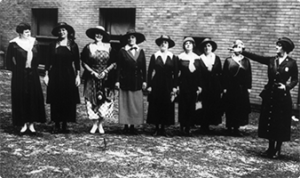Sergeants Benevolent Association of the NYPD
- Home
- Our Legacy
-
-
-
-
1918 Women Police Reserve
Women first began to appear in police departments in the early 20th century… An examination of the early history of women in policing indicates that the work of moral reformers was instrumental in the emergence of Policewomen. During the late 19th century, women’s advocacy groups were heavily involved in social issues. Examples of their efforts include the creation of a separate court for juvenile offenders as well as crime prevention out-reach related to the protection of young women from immoral sexual influences.
-
-
- SBA Leadership
- Commands
- Benefits
-
-
ACTIVE BENEFITS
-
RETIREE BENEFITS
-
MORE RETIREE BENEFITS
-
-
- Resources
-
-
-
-
-
- The Frontline magazine can be read online or printed directly from this website. You can also download a copy to your computer. If you have a story you would like to submit, please contact Robert Mladinich by phone at (917) 204-5916 or by email at rmladinich@sbanyc.org.
-
-
- Donate


History
HISTORY
SBA Roots
The roots of the SBA run as deep as those of the City of New York itself. In 1899, just one year following the consolidation of the city’s five boroughs and the formation of the NYPD, the Department’s supervisory officers formed a fraternal organization known as the Police Sergeants Endowment and Benevolent Association. The new group, led by President Oliver Tims, merged Sergeants’ organizations that had already existed in New York and Brooklyn for more than 10 years, and also included Lieutenants and other high-ranking officers among its membership.
For the next 60 years, the SBA existed largely as an advocacy group, working on behalf of New York’s Sergeants, but holding no firm authority to bargain with the City or press for meaningful reforms. Union leadership was virtually non-existent; currently accepted work standards such as overtime pay, night differential pay and longevity pay were still years away, and while Sergeants were entitled to participate in a single health insurance plan, they were likewise required to pay 50 percent of its premiums.

Early Leadership
That all began to change with the election of Harold Melnick as the SBA’s first modern President in 1961. Over the next 20 years, President Melnick enacted a series of sweeping innovations that would come to revolutionize municipal labor. Under his tutelage, the SBA sought and won individual collective bargaining rights, established its first self-administered health and welfare plan, obtained pay parity with Fire Lieutenants (who hold a comparable rank to the NYPD’s Sergeants), and expanded health insurance coverage and options for Sergeants across the city.
Merging with Transit and Housing
From the time of President Melnick’s election, more than 30 years would pass until the SBA underwent its next substantial change. In 1995, with the consolidation of the Transit and Housing Police Departments into the NYPD, the association merged with the unions representing Sergeants of both departments, bringing the total number of active and retired Sergeants to the level at which it now stands.
 SERGEANTS BENEVOLENT ASSOCIATION
SERGEANTS BENEVOLENT ASSOCIATION

